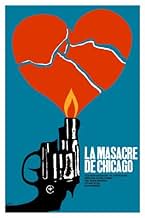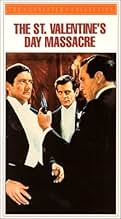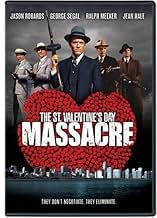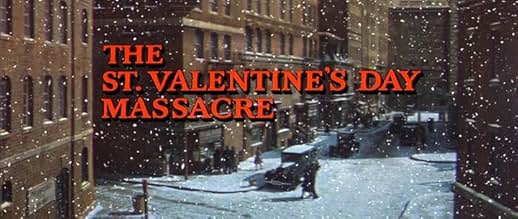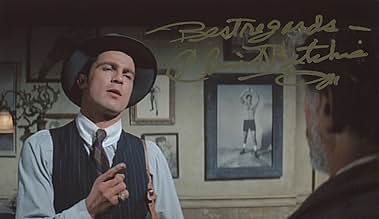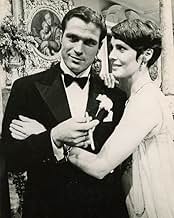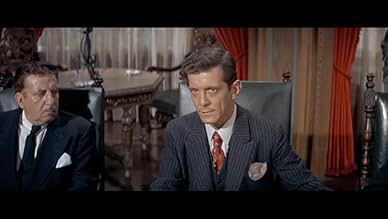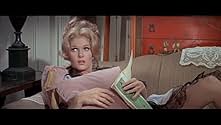NOTE IMDb
6,6/10
5,1 k
MA NOTE
Une surprise de la Saint-Valentin, d'Al Capone pour le gang rival dans le Chicago de 1929.Une surprise de la Saint-Valentin, d'Al Capone pour le gang rival dans le Chicago de 1929.Une surprise de la Saint-Valentin, d'Al Capone pour le gang rival dans le Chicago de 1929.
Joe Turkel
- Jake 'Greasy Thumb' Guzik
- (as Joseph Turkel)
Avis à la une
Chicago, Prohibition, Gangsters, Machine Guns and Hollywood have long been inseparable companions ever since the real Prohibition Era was loosed upon us. Starting with James Cagney in THE PUBLIC ENEMY(1931), LITTLE CEASAR(1931) and SCARFACE(1932) are each powerful films that fit these qualifications like a proverbial glove. Each meets the individual criterion and tell their stories in somewhat different ways of story telling.They each use the point of view of the title characters.
And so that's the way it was, back in the day! And of course there have been revivals of this particular topic and Genre every so often. Hence we have been treated to The Prohibition/Depression Era Gangster films like ROGER TOUHY,GANSTER(1944)*, AL CAPONE and THE PURPLE GANG(both 1959), THE GODFATHER(s), I,II & III(1972,'73, '90) and soon and so forth, down thru the ages.
And of course on TV we had THE LAWLESS YEARS(1959-61) and of course, last but hardly the least,THE UNTOUCHABLES(1959-63)to give further lore to the celluloid underworld. It is probably likely that we'll always have some of these Gangster Soap Operas every so often.
As for this ST. VALENTINE'S DAY MASSACRE, we must say we saw it at the old Double Drive-In on the Southwest Highway in Chicago when it was in newly released/first run status. We saw it again, recently on cable TV, on Turner Classic Films or Fox Movie Channel. It might sound peculiar, but did you ever hear of a movie getting better? Let me explain.
The original viewing was done by a 20 year old, still wet behind the ears kid, who just viewed any movie as another entertainment to be viewed, (devoured-up, if you will) and forgotten. There was really no sense of a "Medium" or being "An Art Form". With age of course, is supposed to come wisdom, or at least a little experience under one's belt.
After a period of nearly 40 years has passed, this writer has found himself to be not a'movie fan',but rather a 'film buff'. The big difference is in the viewing over the years and,more importantly,all of the reading of film books and periodicals containing the history and background information.
As for the title in question, THE ST. VALENTINE's DAY MASSACRE, well I can't say that it was every bit as good when viewed now as it was then. No, because it is even better! The movie was Produced and Directed by Mr. Roger Corman. Now the brain (mine, for what it's worth) takes one name of The Director/Producer and adds it to the venue of a Drive-In Movie Theatre and it computes to a cheapie, a grade "B" film at best. And to be honest, until just recently, I had thought that this movie was a product of the ever popular, Amerkican-Interntional Pictures. After all, that's where Roger Corman used to hang his hat.
This 20th Century-Fox production is really a well done movie, deserving of a new respect and frequent showings.** The costuming, the autos and the sets are all very good and approximate the real locales in Chicago and nearby suburban Cicero, Illinois. The mock up of the famous and infamous Garage on North Wells Street has a very authentic look to it. Even the type of apartment building used by the conspirators is a Chicago-type building, of which there are still thousands of the yet in use there today.
Mr. Corman pursues a form of the Docudrama to a large degree, in unveiling the story. The voice over narration gives us, the viewers the benefit of all that has been learned since then. Also, we have the information of the official Police Investigation now available for the Public Record.In this we have many conclusions that have been made, but not proved, sort of educated guesses.
The story starts out giving the viewer a great deal of background info about the state of Chicago's Underworld at that time in the late 1920's We are privy to the old Northside, Southside, Westside rivalries that the various Gangs were involved in. The previously mentioned Narrator, Voice Actor Par Excellance, Paul Frees, is very busy from beginning to end in supplying us with factual material about the criminal careers of the peoples involved.
As a historical fact we observe the Gangland Killings of Northside Big Shot Hoods Dion O'Bannion(Chicasgo Native John Agar)and Hymie Weiss (Reed Hadley) and the continued battling over territories. Mr.Corman also includes a seemingly fantastic, but factual raid by the Northside Mob on Capone Gang Headquarters. A really large number of autos, replete with multiple Thompson Sub-Machine Guns attacked the favourite watering hole of the Scarface Mob. They failed to kill Capone or anyone of the gang, in spite of perhaps thousands of rounds of that super fast .45 caliber disbursement at the intended target.
Like any Hollywood treatment of a story taken from real life occurrences, there is a lot of filling in gaps and causes of these incidents. The unknown aspects of the people involved and their behaviour is also subject to guess work, albeit an enlightened, educated guess at that. Whatever was known about the characters in question was used as guidelines for molding on-screen persona.
One last time, please take a new look at it. On Cable/Satellite, in VHS or DVD, Purchase or Rental, make an evening with THE ST. VALENTINE's DAY MASSACRE.
* The real Roger Touhy, a Prohibition Era Gangster Headquartered in Northwest Suburban Des Plaines, Illinois sued 20th Century-Fox over this largely fabricated story. Hint To Hollywood: A realistic Roger Touhy story really would make a great film! Check on it!
** Maybe my own fair city, Chicago, is missing the boat on this one! After all, why can't we have a Yearly Massacre Fest? It could be a rival to events all around the country such as: The Kentucky Derby, Mardi Gras, Sadie Hawkins Day or even The Bull Frog Leaping Contest of Calaveras County.
And so that's the way it was, back in the day! And of course there have been revivals of this particular topic and Genre every so often. Hence we have been treated to The Prohibition/Depression Era Gangster films like ROGER TOUHY,GANSTER(1944)*, AL CAPONE and THE PURPLE GANG(both 1959), THE GODFATHER(s), I,II & III(1972,'73, '90) and soon and so forth, down thru the ages.
And of course on TV we had THE LAWLESS YEARS(1959-61) and of course, last but hardly the least,THE UNTOUCHABLES(1959-63)to give further lore to the celluloid underworld. It is probably likely that we'll always have some of these Gangster Soap Operas every so often.
As for this ST. VALENTINE'S DAY MASSACRE, we must say we saw it at the old Double Drive-In on the Southwest Highway in Chicago when it was in newly released/first run status. We saw it again, recently on cable TV, on Turner Classic Films or Fox Movie Channel. It might sound peculiar, but did you ever hear of a movie getting better? Let me explain.
The original viewing was done by a 20 year old, still wet behind the ears kid, who just viewed any movie as another entertainment to be viewed, (devoured-up, if you will) and forgotten. There was really no sense of a "Medium" or being "An Art Form". With age of course, is supposed to come wisdom, or at least a little experience under one's belt.
After a period of nearly 40 years has passed, this writer has found himself to be not a'movie fan',but rather a 'film buff'. The big difference is in the viewing over the years and,more importantly,all of the reading of film books and periodicals containing the history and background information.
As for the title in question, THE ST. VALENTINE's DAY MASSACRE, well I can't say that it was every bit as good when viewed now as it was then. No, because it is even better! The movie was Produced and Directed by Mr. Roger Corman. Now the brain (mine, for what it's worth) takes one name of The Director/Producer and adds it to the venue of a Drive-In Movie Theatre and it computes to a cheapie, a grade "B" film at best. And to be honest, until just recently, I had thought that this movie was a product of the ever popular, Amerkican-Interntional Pictures. After all, that's where Roger Corman used to hang his hat.
This 20th Century-Fox production is really a well done movie, deserving of a new respect and frequent showings.** The costuming, the autos and the sets are all very good and approximate the real locales in Chicago and nearby suburban Cicero, Illinois. The mock up of the famous and infamous Garage on North Wells Street has a very authentic look to it. Even the type of apartment building used by the conspirators is a Chicago-type building, of which there are still thousands of the yet in use there today.
Mr. Corman pursues a form of the Docudrama to a large degree, in unveiling the story. The voice over narration gives us, the viewers the benefit of all that has been learned since then. Also, we have the information of the official Police Investigation now available for the Public Record.In this we have many conclusions that have been made, but not proved, sort of educated guesses.
The story starts out giving the viewer a great deal of background info about the state of Chicago's Underworld at that time in the late 1920's We are privy to the old Northside, Southside, Westside rivalries that the various Gangs were involved in. The previously mentioned Narrator, Voice Actor Par Excellance, Paul Frees, is very busy from beginning to end in supplying us with factual material about the criminal careers of the peoples involved.
As a historical fact we observe the Gangland Killings of Northside Big Shot Hoods Dion O'Bannion(Chicasgo Native John Agar)and Hymie Weiss (Reed Hadley) and the continued battling over territories. Mr.Corman also includes a seemingly fantastic, but factual raid by the Northside Mob on Capone Gang Headquarters. A really large number of autos, replete with multiple Thompson Sub-Machine Guns attacked the favourite watering hole of the Scarface Mob. They failed to kill Capone or anyone of the gang, in spite of perhaps thousands of rounds of that super fast .45 caliber disbursement at the intended target.
Like any Hollywood treatment of a story taken from real life occurrences, there is a lot of filling in gaps and causes of these incidents. The unknown aspects of the people involved and their behaviour is also subject to guess work, albeit an enlightened, educated guess at that. Whatever was known about the characters in question was used as guidelines for molding on-screen persona.
One last time, please take a new look at it. On Cable/Satellite, in VHS or DVD, Purchase or Rental, make an evening with THE ST. VALENTINE's DAY MASSACRE.
* The real Roger Touhy, a Prohibition Era Gangster Headquartered in Northwest Suburban Des Plaines, Illinois sued 20th Century-Fox over this largely fabricated story. Hint To Hollywood: A realistic Roger Touhy story really would make a great film! Check on it!
** Maybe my own fair city, Chicago, is missing the boat on this one! After all, why can't we have a Yearly Massacre Fest? It could be a rival to events all around the country such as: The Kentucky Derby, Mardi Gras, Sadie Hawkins Day or even The Bull Frog Leaping Contest of Calaveras County.
"The Saint Valentine's Day Massacre" is a very good gangster movie, released five years before the all-time great "The Godfather". It's pretty accurate in its chronology, according to the books and documentaries I've seen about the incident, only a couple of dramatic licenses taken. The film unfolds like a documentary, showing the dynamics of the rival gangs and their blood feud. Opening with the killers leaving the garage and then the neighbors discovery of the massacre, it proceeds to detail the buildup to the crime. The victims are introduced, along with the killers and planners. Lots of good actors are in this, veterans of both the big and little screen. Jason Robards has been slammed for his over-the-top portrayal of Al Capone, but everything I've seen about Scarface shows that he was over-the-top himself. George Segal is especially good as a Moran gang member, Peter Gusenberg. Ralph Meeker is a tough , barrel chested Bugs Moran. Both gangs are filled with familiar, competent actors. Jean Hale has a nicely done cameo as a classic "gun Moll", Myrtle, Pete's squeeze. Even Jack Nicholson shows up as a Tommy gunner! The climactic massacre is chillingly accurate using forensic evidence to show how the victims fell and their final positions. All-in-all, a really good movie and record of one of the most famous and shocking events in American criminal history. 8 of 10.
8qrt7
Taking a step back from the intellectual surmising involving Godfather, Goodfellas et al., I thought this was an enjoyable film, 'a live action cartoon' as it was put.
Yep, sure it was a tad formulaic with characters going about their predetermined business and the armchair historians knew the conclusion of the film before it happened. I accept this as valid criticism, but I would stress more that it is supposed to be a quasi-documentary, with the solemn narrator venting sparse mechanical facts about each character and their relevance to the bigger picture as they were introduced. The film itself wasn't trying (I felt) to make a big artistic or intellectual statement, just an enjoyable and disposable piece of cinema. I think that it would be worse if it had been trying top make a 'big point' but fell on its arse, which a number of mobster-related films are guilty of.
As an enjoyable 'get on and enjoy the ride' movie I think it succeeded very well. Having only a basic knowledge of prohibition gangsterland, I found it quite gripping and that the documentary style enhance my enjoyment of an otherwise complex background. The set was also very well done, though Capone was miscast.
I would recommend this to most, unless they are Godfather fans!
8/10
Yep, sure it was a tad formulaic with characters going about their predetermined business and the armchair historians knew the conclusion of the film before it happened. I accept this as valid criticism, but I would stress more that it is supposed to be a quasi-documentary, with the solemn narrator venting sparse mechanical facts about each character and their relevance to the bigger picture as they were introduced. The film itself wasn't trying (I felt) to make a big artistic or intellectual statement, just an enjoyable and disposable piece of cinema. I think that it would be worse if it had been trying top make a 'big point' but fell on its arse, which a number of mobster-related films are guilty of.
As an enjoyable 'get on and enjoy the ride' movie I think it succeeded very well. Having only a basic knowledge of prohibition gangsterland, I found it quite gripping and that the documentary style enhance my enjoyment of an otherwise complex background. The set was also very well done, though Capone was miscast.
I would recommend this to most, unless they are Godfather fans!
8/10
It's incredible to think that this film, Roger Corman's major studio debut, and THE GODFATHER (made by Corman alumnus Coppola) were made within five years of each other. They could be decades apart, in look, in sensibility, in impact. Whereas GODFATHER gropes for a rich, mythic timelessness, MASSACRE seems brittle, thin, a mere pastiche of, variously, 30s Warners gangster films, 40s B-movies, or Corman's own early work. Whereas Coppola's characters have passed into popular culture, Corman's gangsters are thinly characterised, theatrical, parodic; whereas GODFATHER's plot is slow-burning, tense, silent, punctuated with shocking shards of tangible violence, MASSACRE is almost cartoon-like in its relentless gunfire, which, because it's not rooted in character, does not have as traumatic an effect.
Some of us, however, might recoil a little from the major film's more questionable posturing, and MASSACRE has many excellencies. Most immediately pleasurable is the plot, mathematically simple, as Corman narrates the titular bloodbath like a theorem, showing A (Capone) meeting B (Moran) to create C (the massacre). QED. Nothing is allowed interfere with this beautiful simplicity - every scene, every character, every action refers to this theorem alone. Even scenes which seem to illustrate character (eg Peter Gusenberg and Myrtle) only do so to 'explain' why one side got the better of another.
This quality extends to the film as a whole, which is a series of repetitions and mirroring scenes. Another pleasure is the voiceover, which again transforms a conventional narrative about real people into abstract formalism. Like a voice of God, it intrudes without warning, frequently, mixing bald factual details about all the players (eg Such and such, born 1893 in such a place, suspected gun-runner, killer etc., will die on 3 May 1957 of heart failure) with speculation. Before any character has even begun their parts in the film, their life stories are known to us. This robs them of everything that makes us human - motivation, hope, action. Sartre said we are what we do. Not here. Robbed of human characteristics, they become mere ciphers, playing out their inevitable fates, and denying the viewer the kind of emotional empathy that Coppola will dubiously over-indulge in.
Despite the (relatively) high budget, production values do nothing to make the film more realistic. Indeed, the uniformity of colour (predominantly grey), the repetition of scenes and places, the reduction of sequences to sheer functionality, makes the film increasingly artificial. The theatricality of the acting adds to this, with Robards especially hamming away to amusingly grand effect, but theatricality is embedded too, as narratively crucial scenes become sites for rhetoric, oratory, dramatic performance, an actor declaiming to an enrapt public, hanging (for dear life) to his every word.
Add to all this Corman's stunning, playful direction, confident and fluid, making interiors and objects live, fixing characters in their place. The violent scenes are expertly choreographed, if they aren't disturbing, their formal excellence is undiminished. All this formalism is not an empty, academic exercise. By revealing the phoniness of his subject matter, Corman reveals the processes of myth-making that, especially through the cinema, curiously glamourised an era, when America was in thrall to a number of violent fascists.
Corman is not seriously moralistic, he is cheerfully aware of human nature's strange pulls - he shows how the need for violence and sensation in cinema is close to the fascistic, but also undeniable. It is a trap Coppola doesn't always avoid. The score, which makes ragtime eerily modernist, is astounding, while Corman reveals, as in TALES OF TERROR, that he has a canny sense of the domestic's comic violence - the Pete/Myrtle scene is a hilarious-troubling classic.
Some of us, however, might recoil a little from the major film's more questionable posturing, and MASSACRE has many excellencies. Most immediately pleasurable is the plot, mathematically simple, as Corman narrates the titular bloodbath like a theorem, showing A (Capone) meeting B (Moran) to create C (the massacre). QED. Nothing is allowed interfere with this beautiful simplicity - every scene, every character, every action refers to this theorem alone. Even scenes which seem to illustrate character (eg Peter Gusenberg and Myrtle) only do so to 'explain' why one side got the better of another.
This quality extends to the film as a whole, which is a series of repetitions and mirroring scenes. Another pleasure is the voiceover, which again transforms a conventional narrative about real people into abstract formalism. Like a voice of God, it intrudes without warning, frequently, mixing bald factual details about all the players (eg Such and such, born 1893 in such a place, suspected gun-runner, killer etc., will die on 3 May 1957 of heart failure) with speculation. Before any character has even begun their parts in the film, their life stories are known to us. This robs them of everything that makes us human - motivation, hope, action. Sartre said we are what we do. Not here. Robbed of human characteristics, they become mere ciphers, playing out their inevitable fates, and denying the viewer the kind of emotional empathy that Coppola will dubiously over-indulge in.
Despite the (relatively) high budget, production values do nothing to make the film more realistic. Indeed, the uniformity of colour (predominantly grey), the repetition of scenes and places, the reduction of sequences to sheer functionality, makes the film increasingly artificial. The theatricality of the acting adds to this, with Robards especially hamming away to amusingly grand effect, but theatricality is embedded too, as narratively crucial scenes become sites for rhetoric, oratory, dramatic performance, an actor declaiming to an enrapt public, hanging (for dear life) to his every word.
Add to all this Corman's stunning, playful direction, confident and fluid, making interiors and objects live, fixing characters in their place. The violent scenes are expertly choreographed, if they aren't disturbing, their formal excellence is undiminished. All this formalism is not an empty, academic exercise. By revealing the phoniness of his subject matter, Corman reveals the processes of myth-making that, especially through the cinema, curiously glamourised an era, when America was in thrall to a number of violent fascists.
Corman is not seriously moralistic, he is cheerfully aware of human nature's strange pulls - he shows how the need for violence and sensation in cinema is close to the fascistic, but also undeniable. It is a trap Coppola doesn't always avoid. The score, which makes ragtime eerily modernist, is astounding, while Corman reveals, as in TALES OF TERROR, that he has a canny sense of the domestic's comic violence - the Pete/Myrtle scene is a hilarious-troubling classic.
It took me a while before I really appreciated this film. Despite its flaws, this is probably the most serious, accurate, and restrained treatment on the subject you're ever going to get without watching a straight-out documentary. What you have is sort of a "docudrama" on the infamous St. Valentine's Massacre, and the events leading up to it.
Not that the film ST. VALENTINE'S DAY MASSACRE takes itself too seriously. It doesn't, but all of the over-the-top acting merely enhances the product. There are still some inaccuracies but the story adheres so closely to the actual facts that these discrepancies are easily forgiven. The violence shown might have been considered sensational in 1967, and this was most probably the intent, but it's pretty tame by today's standards. And if it falls short of being a great film, it's a near miss rather than one by a mile.
In this dramatization of the final showdown between the South Side and North Side gangs for control of Chicago's underworld in 1929, Jason Robards takes center stage as Al Capone. He might have been much older and looked nothing like the real Capone but then so what. As they say, you want an interpretation and not an impersonation. His histrionic performance, with all of its eye-rolling and exaggeration, strikes just the right note and does its part to help keep things moving throughout. This was an actor who knew what he was doing, and exactly how he should play it in this instance.
But it takes a while for Capone to show up, finally seen casually arriving in a limousine on his way to a board meeting with his underlings. The first hood to show up on screen is played (some could say overplayed) by George Segal as Pete Gusenberg, a member of the rival gang, who proceeds to intimidate a bar-owner. Actually, Segal gives a rather convincing performance as a very smug, arrogant thug who enjoys pushing people around, and acting like he's one bad dude, with guns and a gang to back him up.
A very effective technique employed throughout the film, provided by narrator Paul Frees, is the frequent voiceover commentary on various characters. Information is given, such as that the individual was born on this or that date, at whatever place, something about his background, and his place in the particular gang, etc. (often including his time of death as well). Not only does this provide an easily-understood guide for who's who, but it helps to get the viewer involved with these characters however unsympathetic or unsavory they might be.
In brief but well-played roles, on the Capone side, there's Paul Richards as Charlie Fischetti, Joseph Turkel as Jake Guzik, and Harold Stone as Frank Nitti, with a more conspicuous role played by Clint Richie as Jack McGurn, who gets put in charge of organizing the title massacre. That particularly bloody episode was designed to rid Capone of his archenemy and chief rival, George "Bugs" Moran, capably played by tough-talking Ralph Meeker. Moran was the head of the North Side gang, and in flashback scenes we're shown what befell Moran's two predecessors, Dion O'Bannion (played by John Agar) and Hymie Weiss (played by Reed Hadley).
The rest of the cast is made up of many fine actors, some familiar and others less so. Among the unlucky seven who have an appointment up against a certain garage wall, besides Segal's Pete Gusenberg, included are David Canary as Pete's brother Frank, Kurt Krueger as Moran's top lieutenant, Milton Frome as the gang's accountant, Joseph Campanella as a low-level employee, Bruce Dern as a mechanic, and Mickey Deems as a hanger-on. Not to be overlooked is the always excellent Frank Silvera as Nick Sorello, a not completely innocent pawn used in trying to set up Moran.
Almost every actor with a speaking role gets at least one good scene and a chance to shine, from the major actors right on down to several of the minor supporting players. An attempt is made to show some of the camaraderie and interaction among the members of each gang. The careful planning of the "hit" is laid out, including an amusing scene where two gunmen, posing as musicians, are renting a room from a wary landlady.
Such details add to the plot and the characterizations, with keen attention being paid to recreating a 1920s atmosphere, and don't forget all of the various gunplay and assorted mayhem along the way, leading up to the fateful massacre. They even throw in a completely superfluous fight between Gusenberg (Segal) and his girlfriend over a fur coat. Since it's only a brief rest from the action, and we get to rest our eyes on Jean Hale, then what's the harm. Enjoy this trip back in time to gangland Chicago.
Not that the film ST. VALENTINE'S DAY MASSACRE takes itself too seriously. It doesn't, but all of the over-the-top acting merely enhances the product. There are still some inaccuracies but the story adheres so closely to the actual facts that these discrepancies are easily forgiven. The violence shown might have been considered sensational in 1967, and this was most probably the intent, but it's pretty tame by today's standards. And if it falls short of being a great film, it's a near miss rather than one by a mile.
In this dramatization of the final showdown between the South Side and North Side gangs for control of Chicago's underworld in 1929, Jason Robards takes center stage as Al Capone. He might have been much older and looked nothing like the real Capone but then so what. As they say, you want an interpretation and not an impersonation. His histrionic performance, with all of its eye-rolling and exaggeration, strikes just the right note and does its part to help keep things moving throughout. This was an actor who knew what he was doing, and exactly how he should play it in this instance.
But it takes a while for Capone to show up, finally seen casually arriving in a limousine on his way to a board meeting with his underlings. The first hood to show up on screen is played (some could say overplayed) by George Segal as Pete Gusenberg, a member of the rival gang, who proceeds to intimidate a bar-owner. Actually, Segal gives a rather convincing performance as a very smug, arrogant thug who enjoys pushing people around, and acting like he's one bad dude, with guns and a gang to back him up.
A very effective technique employed throughout the film, provided by narrator Paul Frees, is the frequent voiceover commentary on various characters. Information is given, such as that the individual was born on this or that date, at whatever place, something about his background, and his place in the particular gang, etc. (often including his time of death as well). Not only does this provide an easily-understood guide for who's who, but it helps to get the viewer involved with these characters however unsympathetic or unsavory they might be.
In brief but well-played roles, on the Capone side, there's Paul Richards as Charlie Fischetti, Joseph Turkel as Jake Guzik, and Harold Stone as Frank Nitti, with a more conspicuous role played by Clint Richie as Jack McGurn, who gets put in charge of organizing the title massacre. That particularly bloody episode was designed to rid Capone of his archenemy and chief rival, George "Bugs" Moran, capably played by tough-talking Ralph Meeker. Moran was the head of the North Side gang, and in flashback scenes we're shown what befell Moran's two predecessors, Dion O'Bannion (played by John Agar) and Hymie Weiss (played by Reed Hadley).
The rest of the cast is made up of many fine actors, some familiar and others less so. Among the unlucky seven who have an appointment up against a certain garage wall, besides Segal's Pete Gusenberg, included are David Canary as Pete's brother Frank, Kurt Krueger as Moran's top lieutenant, Milton Frome as the gang's accountant, Joseph Campanella as a low-level employee, Bruce Dern as a mechanic, and Mickey Deems as a hanger-on. Not to be overlooked is the always excellent Frank Silvera as Nick Sorello, a not completely innocent pawn used in trying to set up Moran.
Almost every actor with a speaking role gets at least one good scene and a chance to shine, from the major actors right on down to several of the minor supporting players. An attempt is made to show some of the camaraderie and interaction among the members of each gang. The careful planning of the "hit" is laid out, including an amusing scene where two gunmen, posing as musicians, are renting a room from a wary landlady.
Such details add to the plot and the characterizations, with keen attention being paid to recreating a 1920s atmosphere, and don't forget all of the various gunplay and assorted mayhem along the way, leading up to the fateful massacre. They even throw in a completely superfluous fight between Gusenberg (Segal) and his girlfriend over a fur coat. Since it's only a brief rest from the action, and we get to rest our eyes on Jean Hale, then what's the harm. Enjoy this trip back in time to gangland Chicago.
Le saviez-vous
- AnecdotesFor the massacre scene in the garage, the actors playing the slain gangsters were shown photos and directed as how to fall so their positions were identical to the real photos of the massacre. Two actors bumped together on the way down. After studying photographs they realized they had fallen and collided in the exact way the slain gangsters had fallen and had landed in the correct positions.
- Citations
Reporter: Y'know some are sayin' that it really was the cops who shot those men.
Bugs Moran: You must be new to this town, mister. Only Al Capone kills like that.
- ConnexionsEdited into Capone (1975)
Meilleurs choix
Connectez-vous pour évaluer et suivre la liste de favoris afin de recevoir des recommandations personnalisées
- How long is The St. Valentine's Day Massacre?Alimenté par Alexa
Détails
- Date de sortie
- Pays d’origine
- Langues
- Aussi connu sous le nom de
- Le Massacre de la Saint-Valentin
- Lieux de tournage
- Desilu Studios - 9336 W. Washington Blvd., Culver City, Californie, États-Unis(street scenes, garage - exteriors)
- Société de production
- Voir plus de crédits d'entreprise sur IMDbPro
Box-office
- Budget
- 1 000 000 $US (estimé)
- Durée1 heure 40 minutes
- Couleur
- Rapport de forme
- 2.35 : 1
Contribuer à cette page
Suggérer une modification ou ajouter du contenu manquant

Lacune principale
By what name was L'Affaire Al Capone (1967) officially released in India in English?
Répondre

